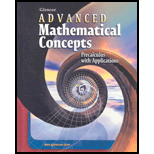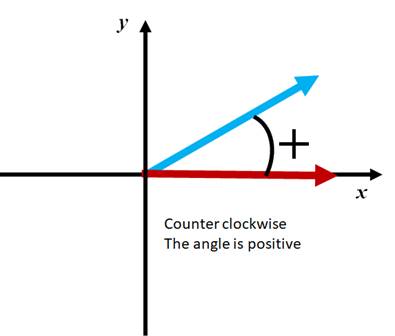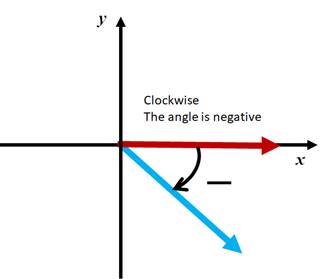
To describe: The difference between an angle with a positive measure and an angle with a negative measure.
Explanation of Solution
Given information: An angle with a positive measure and an angle with a negative measure
Calculation:
An angle in standard position has one of its rays aligned on the x -axis pointing to the right in the positive direction.
Think of making an angle as taking another ray on top of this first one and moving it up or down to form an angle with the first one.
Kind of like moving the minute hand of a clock clockwise or counter-clockwise. If the second ray moves up (counter-clockwise) you create a positive angle, if the second ray is moved down (clockwise) you create a negative angle.
The positive or negative has to do with which direction you move.


Chapter 5 Solutions
Advanced Mathematical Concepts: Precalculus with Applications, Student Edition
Additional Math Textbook Solutions
A First Course in Probability (10th Edition)
Algebra and Trigonometry (6th Edition)
Elementary Statistics (13th Edition)
A Problem Solving Approach To Mathematics For Elementary School Teachers (13th Edition)
College Algebra with Modeling & Visualization (5th Edition)
- Calculus lll May I please have the solution for the following exercise? Thank youarrow_forward2z = el+cos(x+y) 24 = olt etz dy = 1 dt dz e²² + cos (+²+1++). 2++ (1+++cos C+²+1++) (+) dz 2+. etz 2t, + 2+⋅ cos (t² +++ 1) + t (1++1 dt + cos (+²+++1) 2. W= (yz) (yz) x x=e8++ 2 y= 3² + 3st, z=sent, hallar 2w 2w د 2u 2t 25 2t AX119 S Narrow_forwardpractice for test please help!arrow_forward
- practice for test please help!arrow_forwardX MAT21 X MindTa X A 26308 X Answer X M9 | C X 10 EKU-- × E DNA S X H. pyle x C static/nb/ui/evo/index.html?elSBN=9780357038406&id=339416021&snapshotld=877369& CENGAGE MINDTAP nctions, Limits, and the Derivative In Exercises 15, 16, 17, 18, 19, and 20, refer to the graph of the function f and determine whether each statement is true or false. -3-2-1 4- 3+ y= f(x) 2 1+ x 1 2 3 4 5 6 AA aarrow_forwardex MAT21 X MindTa X A 26308 X Home X M9|C X 10 EKU-- × E DNA S X H. pylo x C Ch om/static/nb/ui/evo/index.html?elSBN 9780357038406&id=339416021&snapshotld=877369& CENGAGE MINDTAP : Functions, Limits, and the Derivative E 3 In Exercises 21, 22, 23, 24, 25, 26, 27, 28, 29, 30, 31, 32, 33, 34, 35, 36, 37, and 38, find the indicated one-sided limit, if it exists. 21. lim (2x+4) x+1+ Answer 22. lim (3x-4) x-1 23. lim x-3 x+2x+2 Answer 24. lim x+2 x1+x+1 1 25. lim x+0+ x Answer▾ 26. lim 1 x40X x-1 27. lim x+0+ x²+1 Answer 28. lim x + 1 x-2+ x2 -2x+3 $ 4 % 5 MacBook Pro A 6 27 & * ( 8 9 AA a searrow_forward
- 1. 2. In Exercises 1, 2, 3, 4, 5, 6, 7, and 8, use the graph of the function f to find lim f(x), lim f(x), and xa x+a+ lim f(x) at the indicated value of a, if the limit exists. x a Answ 2: the init X1starrow_forward1. 2. In Exercises 1, 2, 3, 4, 5, 6, 7, and 8, use the graph of the function f to find lim f(x), lim f (x), and xa x→a+ lim f (x) at the indicated value of a, if the limit exists. xa Ans 2: the lin X1st S 4+ 3 y = f(x) 2 1 2 3 4 5 6 a=3arrow_forward1. 2. In Exercises 1, 2, 3, 4, 5, 6, 7, and 8, use the graph of the function f to find lim f(x), lim f(x), and xa x+a+ lim f(x) at the indicated value of a, if the limit exists. x a Answ 2: the init X1starrow_forward
- Chrome File Edit View History Bookmarks TC MyTCC: Studer × ALTI Launch ✓ Profiles Tab Window Help O Tue Mar 25 12:42 AM Pearson MyLak × P Course Home ✓ MasteringChen X Use the orbital × | My Uploads | b x Phosphorus El x + session.chemistry-mastering.pearson.com/myct/itemView?assignmentProblemID=234894331 A New Chrome available : (? Helparrow_forwardPlease find the open intervals where the functions are concave upward or concave downward. Find any inflection points also thanks!Note: This is a practice problem!arrow_forwardUse the graph below to evaluate each limit. -11 -10 -9 -8 -6 -5 -- + -0.3 -3 -2 -0.2 -0.1- ▼ 0 1 2 -0.1- -0.2- -0.3- 3. 4 5 -0 6 -0:4 -edit-graph-on- desmos lim f(x)= _9-←x lim f(x)⇒ x→1 ☐☐ lim f(x)⇒ +9-←x lim f(x)⇒ x→−4+ lim f(x)⇒ x→1+ lim f(x)= x→2+ lim f(x)⇒ x→-4 lim f(x)⇒ x→2arrow_forwardarrow_back_iosSEE MORE QUESTIONSarrow_forward_ios
 Calculus: Early TranscendentalsCalculusISBN:9781285741550Author:James StewartPublisher:Cengage Learning
Calculus: Early TranscendentalsCalculusISBN:9781285741550Author:James StewartPublisher:Cengage Learning Thomas' Calculus (14th Edition)CalculusISBN:9780134438986Author:Joel R. Hass, Christopher E. Heil, Maurice D. WeirPublisher:PEARSON
Thomas' Calculus (14th Edition)CalculusISBN:9780134438986Author:Joel R. Hass, Christopher E. Heil, Maurice D. WeirPublisher:PEARSON Calculus: Early Transcendentals (3rd Edition)CalculusISBN:9780134763644Author:William L. Briggs, Lyle Cochran, Bernard Gillett, Eric SchulzPublisher:PEARSON
Calculus: Early Transcendentals (3rd Edition)CalculusISBN:9780134763644Author:William L. Briggs, Lyle Cochran, Bernard Gillett, Eric SchulzPublisher:PEARSON Calculus: Early TranscendentalsCalculusISBN:9781319050740Author:Jon Rogawski, Colin Adams, Robert FranzosaPublisher:W. H. Freeman
Calculus: Early TranscendentalsCalculusISBN:9781319050740Author:Jon Rogawski, Colin Adams, Robert FranzosaPublisher:W. H. Freeman
 Calculus: Early Transcendental FunctionsCalculusISBN:9781337552516Author:Ron Larson, Bruce H. EdwardsPublisher:Cengage Learning
Calculus: Early Transcendental FunctionsCalculusISBN:9781337552516Author:Ron Larson, Bruce H. EdwardsPublisher:Cengage Learning





